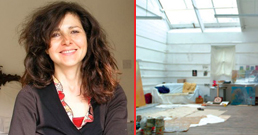Dariush Rajabian
Few people outside of artistic circles have heard of Partou Zia, the Iranian painter, who died of cancer last March at the age of 49. She is not yet prominent in her native
Partou Zia was born in
Partou showed a great interest in drawing and painting when she was still studying at
Partou Zia taught English in
“She felt that painting was her only path in life – not merely a side project,” said Peyman, Partou’s sister, in an interview with Jadidonline.
Thus, painting moved from the fringes to the centre of Partou’s life. However, her creativity knew few bounds and she not only wrote numerous poems but also an extensive diary, all in English.
“We had always written down our daily observations since our childhood”, says Peyman. “But for Partou it became a kind of religious obligation, so that she could never go to bed before filling a couple of pages in her diary. She wrote poems and other stuff as well.”
After graduating from Slade School of Fine Art, Partou Zia took a creative break to visit the
Partou Zia stayed in
Partou had turned her cottage, within the pretty seaside town of
In 2003, Partou was awarded with the studio residency by Tate St Ives in collaboration with another trust. According to Penny Florence of The Guardian, “through this scheme, talented artists are given time in the historic Porthmeor Studios in St Ives to work towards a show at the Tate. Here many of the great pioneers of British Modernism worked, including Ben Nicholson and Patrick Heron.”
“Entering the Visionary Zone,” a series of mysterious paintings, was created during this residency. One needs to be familiar with the peculiar style of the painter beforehand to understand the meaning of the series.
Partou Zia had two solo exhibitions at Art First in
During the last months of her life, Partou wrote several plays and stories - each of them reflecting the writer’s struggle to find new forms of expression.
“Partou managed through sheer will, dedication to her work and love of life, to almost double the two years she was given when diagnosed with advanced cancer,” writes Penny Florence. “The diagnosis angered her, as would any suggestion that she should take it easy or suspend her plans.” She wrote and painted in bed and six months before her imminent demise, Partou completed two large and exceptional last works of art.
Her last painting is exhibited at Tate St Ives. The gallery held a special event commemorating Partou Zia.
“Partou's canvases bring a fresh note to the long established tradition of story telling,” reads Partou Zia’s biography on the Art First website. “She has been inspired by the writing and illustrations of William Blake, and her work explores a personal journey of self-discovery. Through these vibrant, painterly canvases, she draws the viewer into her dream like memory. Her own language is highly original, evolving a personal mythology of motifs and symbols that include lovers, sleepers, dreamers and readers, set within evocative interiors or luminous landscapes.”


